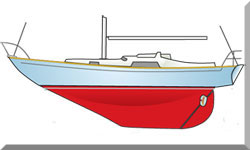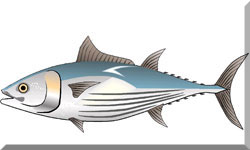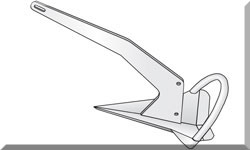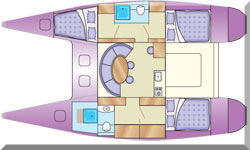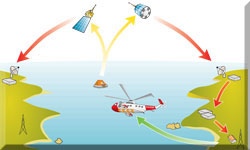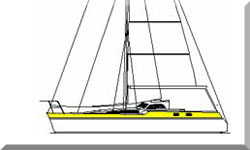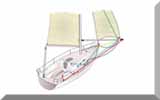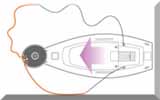- Home
- Bluewater Sailing
- Sailboat Spares for Long Distance Cruising
Sailboat Spares & Equipment for Long Distance Cruising
In a Nutshell
Sailboat Spares for Long Distance Cruising are your non-negotiable insurance policy. You can’t take everything, but you absolutely must prioritise components that, if they fail, will jeopardise safety or mission completion—your ability to navigate, maintain propulsion, keep the rig standing, or communicate. The veteran sailor’s approach focuses on redundancy and carrying repair kits for high-wear items (impellers, filters, deck gear) and critical systems (alternator, auto-pilot, steering). This is less a shopping list and more an objective risk assessment of your boat’s specific weak spots before you cast off the lines.

Table of Contents
- The Sailor's Risk Assessment
- Electrical Spares
- Engine Spares
- Sails & Rigging
- Navigation, Communication & Safety Electronics Spares
- Miscellaneous Spares & Equipment
- Mechanical & Electrical Tools
- Field-Repair & Tool Priority Table
- System-Specific Pre-Passage Testing
- Service Kits
- Essential High-Strength Temporary Repair Materials
- The Critical Spares Inventory & Log
- Medical Equipment
- Summing Up
- Frequently Asked Questions (FAQs)
The old adage says the only way to be absolutely sure of having sufficient sailboat spares & equipment for long distance cruising is to tow an identical yacht astern. Not a very practical solution, but Murphy's Law seems to dictate that you’ll otherwise have a spare part for everything but the one thing that actually breaks.
Modern cruising boats are far more complex machines than they were a generation or two ago. They're bristling with electrics and electronics, and the diesel engines are now finely-tuned common rail or electronically-managed units. It's simply impossible to have a spare part aboard for everything, irrespective of the size of your boat or the depth of your pocket.
While it’s true that the popularity of sailing has led to the spread of good chandlers along most popular cruising routes, Murphy is usually inclined to amuse himself when you’re far offshore—not when you’re conveniently close to a well-equipped service point.
So, starting with the premise that you can’t have a spare part for everything, how do you decide exactly what to take aboard?
The Sailor's Risk Assessment
The decision-making process is actually straightforward, though time-consuming. You must be brutally honest about which parts of your boat are most vulnerable to failure through loss, damage, or general wear and tear, and what the consequences of that specific failure would be.
- Critical Failure (Must Fix at Sea): Loss of steering, loss of propulsion, major rig failure, loss of navigation ability. These demand a spare part or a reliable, robust means of repair.
- Mission-Limiting Failure (Need Fixing Soon): Loss of freshwater pump, toilet blockage, primary charging failure (but with backup), significant leak. You can live with this for a while, but it needs addressing at the next port.
- Convenience Failure (Can Wait): Loss of a non-essential cabin light, freezer failure, minor deck fitting failure. These can generally wait until you reach shoreside facilities.
An experienced ocean sailor's focus is always on the first category. You must secure the ability to keep the boat going, keep the crew safe, and keep navigating.
Electrical Spares
The modern sailboat is a highly dependent electrical beast. A list of consumables and key components is vital. These are cheap, small, and can solve huge problems when you need them.
- Bulbs and fuses for all electric appliances
- Circuit breakers
- Electrical wiring of various sizes
- Crimp connectors
- Insulating tape
- Self-amalgamating tape
- Heat shrink tape and tubing
- Cable ties
- Petroleum jelly or silicone grease (for corrosion protection)
- De-ionised water (for flooded lead-acid batteries)
- Voltage regulator for solar panels (a common failure point)
- Voltage regulator for wind generator (another high-wear component)
Engine Spares
For a long ocean passage, your engine is your primary source of propulsion and charging. The spare alternator is non-negotiable—if your primary unit fails, you have no way to recharge batteries, which is mission-critical.
- Spare alternator
- Spare raw water pump (or a comprehensive service kit including the whole seal housing)
- Spare fuel pump
- Spare injectors (if you have an older, mechanically injected engine)
- Air cleaner element
- Spare cooling water impellers and impeller replacement kits
- Spare engine oil filters and primary and secondary fuel filters (have plenty—diesel bug is real)
- Spare V belts
- Thermostat
- Alternator diode
- Engine and gearbox oil
- Various oils and greases for pumps, stern glands, and general use
- Gasket material and sealants
- PTFE tape
- Penetrating oil in aerosol can
Sails & Rigging
Keeping the rig standing and the sails driving the boat is the core of offshore sailing. My emphasis is always on robust repair, which is why a proper sailmaker's sewing machine is on the list—it’s a major investment, but well worth it. Be sure to consult Sail Care & Maintenance: A Guide to Extending Your Sail's Life for preventative measures.
- Sail repair kit including sail cloth, sail slides, and jib hanks
- Sailmaker's palm and assorted needles
- Sewing machine (a Reeds Sailmaker or similar heavy-duty, manual machine)
- Assorted ropes and cordage (including sacrificial chafe gear)
- Spare sheets and halyards (at least one per diameter)
- Replacement blocks and jammers for the mainsheet tackle and kicker
- Assorted blocks including a couple of heavy-duty snatch blocks
- Shackles of various types and sizes
- Splicing fids and tools
- Riggers knife
- Spare sail battens
- Spare bottle screws for each shroud diameter
- Turnbuckles and toggles
- Assorted clevis pins and split pins
- Norseman or similar re-useable terminal fittings for each wire diameter (as a true emergency fix)
Navigation, Communication & Safety Electronics Spares
This is the section where an experienced sailor's perspective really counts. The auto-pilot servo unit, in particular, is one of the most overworked and likely to fail components on a long passage. Having a spare is peace of mind.
- Auto-Pilot Drive Unit: A spare linear or hydraulic drive unit (or at least the motor/gearbox assembly, if possible)
- VHF/AIS Antenna: Spare emergency VHF antenna
- Power: 12v inverter
- Redundancy: Handheld VHF (as backup to fixed unit), handheld GPS (as backup to fixed unit), handheld compass with bulkhead clip (as backup to main steering compass)
- Sensor Spares: Spare depth transducer (if easily accessible), spare wind sensor propeller cups (easily damaged by birds or knocks)
- Fuses and Wiring: Spare plugs, connectors, and fuses specific to high-value electronics (e.g., plotter, radar)
Miscellaneous Spares & Equipment
This covers the critical 'other' stuff that can cause a major headache if it breaks. The emergency tiller is only as good as its deployment, so ensure it’s easily accessible.
- Emergency tiller
- Spare servo pendulum blade for self-steering (if applicable)
- Spare plywood windvane for self-steering gear (if applicable)
- Spare winch handles (you will drop them)
- Spare Windex (or similar)
- Hose clamps and various lengths of hose (for plumbing, engine, and bilge)
- Dinghy repair kit
- Pressure regulator for gas bottle
- Sheer pins for outboard motor propellor
- Spark plugs for outboard motor
- Spare blades for wind generator
- Spare electric bilge pump
- Spare air cylinders for foghorn
- Spare batteries for torches and electronic devices
- Stainless steel nuts, bolts and washers of various lengths and diameters
- Assorted stainless steel self-tapping screws
- Various connectors for shoreside power supplies
Mechanical & Electrical Tools
The problem with tools is knowing where to stop! As a practical sailor, I only carry tools I've actually needed to use in anger, focusing on durability and marine-grade quality. A digital multimeter is an absolute necessity for diagnostics—you can’t fix what you can’t measure.
- Digital multimeter
- 12v cordless drill with assorted bits
- Socket set, spanner set, and set of Allen keys
- Screwdrivers of various types and sizes (including small precision ones)
- Pliers of various types and sizes, including needle nose pliers and Vice grips
- Wire cutters and strippers, and crimping tool
- Oil and fuel filter wrenches, and oil change pump
- Hacksaw and spare blades, and metal files
- Craft knife and spare blades
- Ball peen hammer, club hammer, claw hammer, and rubber or plastic mallet
- Butane filled or 12v soldering iron, and heat gun
- Engine workshop manual
- Gas torch with soldering attachment
- Grease gun and oil can
- Large and small adjustable spanner
- Polarity tester
- Marlin spike, small plane, wood chisels, and whetstone
- A spirit level (for levelling up the boat when on the hard—incredibly useful for fridge repairs and antifouling)
- Large magnet (for retrieving dropped small metal items)
Field-Repair & Tool Priority Table
Knowing which tool solves which problem is the key to field repair. This table links critical scenarios to the spares and tools you’ll need immediately.
| Critical Failure Scenario | Primary Spare/Material | Essential Tools Required |
|---|---|---|
| Cooling Hose Burst | Silicone Self-Fusing Tape & Hose Clamps | Screwdriver (hose clamps) & Rigger's Knife |
| Rigging Wire Break | Norseman Fitting & Spare Wire | Riggers Knife & Spanner Set & Bench Vice (if portable) |
| Alternator Failure | Spare Alternator & Spare V Belts | Spanner Set & Digital Multimeter & Engine Workshop Manual |
| Through-Hull Leak | Soft Wood Plugs & Underwater Epoxy | Club Hammer (to tap plug) & Scraper (for epoxy prep) |
System-Specific Pre-Passage Testing
Carrying spares is necessary, but the surest way to avoid using them is rigorous, proactive testing of your systems—especially the backups. This is what separates preparation from mere provisioning.
- Steering Systems:Test the Emergency Tiller. Ensure it fits, clears all cockpit gear, and moves the rudder through its full range of motion. Never leave this to chance.
- Auto-Pilot/Redundancy: If you carry a spare drive unit, run the system on it for 30 minutes. If you rely on a secondary system (like a wind vane), ensure all its control lines are free and spare blades are accessible.
- Fuel System Integrity: Before the passage, intentionally swap the primary fuel filters for the first spare set. This confirms the seals seat correctly, you know how to bleed the system efficiently, and your spares are the right fit.
- Water Management: Test all manual bilge pumps (at full stroke) and run the electric bilge pump on its lowest setting. If you have a watermaker, run it using the spare pre-filters to confirm fit and function.
Service Kits
Service kits are the single most effective way to carry essential spares in a compact form. The service kit for the sea toilet, for instance, is far more useful than a handful of random seals.
- Service kit for all manual pumps (including bilge pumps)
- Service kit for sea toilet
- Service kit for sheet and halyard winches
- Service kit for the watermaker and plenty of spare filters
- Spare seals for each deck hatch
- Fibreglass repair kit, including mat, cloth resin and underwater epoxy (crucial for structural repairs)
The comprehensive preparation required for a yacht's systems is only part of the story; for a full understanding of the philosophy and seamanship behind ocean voyaging, refer to The Ultimate Blue Water Sailing Guide: Preparation & Seamanship for the Ocean.
Essential High-Strength Temporary Repair Materials
When failure occurs, you often need materials for improvisation that are stronger and more specialised than those in a typical toolbox. These items allow you to effect a temporary, structural fix until the next port.
- Epoxy Putty (Underwater Grade): A fast-setting, powerful adhesive for sealing through-hull leaks, minor hull breaches, or stabilising cracked components in an emergency.
- High-Tenacity Strapping/Webbing: Far stronger than rope, this flat webbing is ideal for jury-rigging broken boom fittings, stabilizing a partially-failed mast, or securing heavy deck cargo after a knockdown.
- Through-Hull Plugs: An assortment of softwood or composite conical plugs sized to fit every single through-hull fitting on your boat. If a seacock or hose bursts, these are the immediate solution.
- Military-Grade Duct Tape: This isn't the cheap silvery stuff. You want the thick, high-adhesive, waterproof kind for quick chafe protection, emergency sail patches, and temporary portlight seals.
- Silicone Self-Fusing Tape: This non-adhesive rubber tape creates a watertight, high-pressure bond when stretched and wrapped, making it invaluable for sealing leaking cooling hoses or broken exhaust lines.
The Critical Spares Inventory & Log
A pile of spares is only as good as your ability to find the right part, immediately. An experienced ocean sailor knows that logistics and administration are as vital as the tools themselves.
- Digital and Physical Inventory: Maintain a simple spreadsheet (digital) and a laminated printout (physical) listing the name, part number, system, and storage location (e.g., 'Starboard Aft Locker, Box 3').
- Part Number Discipline: Ensure the original manufacturer's part number (or cross-reference) is written directly on the packaging of every filter, impeller, seal, and electronic component. You can't search for a replacement without a number.
- Perishable Item Rotation and Shelf Life: You must actively manage items that fail due to age, not use. Gasket and seal kits (rubber/neoprene) should be replaced if they're over five years old, regardless of use. Check the date codes on all liquid adhesives and sealants (Sikaflex, two-part epoxies); if they've hardened or won't mix smoothly, they are useless. Log the expiry dates for all safety gear like flares and EPIRB batteries.
- Custom System Kits: Assemble all the small consumables (seals, O-rings, fuses, small screws) needed for one complex piece of gear (e.g., watermaker, toilet, deck wash pump) into its own small, labelled, waterproof container.
Medical Equipment
I am no medic, but offshore sailing demands a comprehensive, well-organised kit that goes beyond the basic coastal requirements. For an Atlantic crossing, I always ensure I have sufficient antibiotics and analgesics, along with the means to deal with severe cuts and burns, as a doctor is days away.
| Item Type | Examples of Kit Contents |
|---|---|
| Analgesics & Infection | Analgesics (pain killers), Antibiotics, Antiseptic & antifungal creams |
| Wound Care | Assorted plasters, Various sized bandages & dressings, Gauze swabs, Adhesive tape, Splinter forceps, Disposable gloves |
| Eye & Allergies | Antihistamine, Eye drops, Eyepad with bandage, Plastic eye bath |
| General & Essentials | Clinical thermometer, Seasickness tablets, Sunscreen, Lip moisturiser, Silver foil blanket |
Summing Up
The sheer volume of spares can be overwhelming, but remember the lesson from my own Atlantic crossing preparation: the challenge is always twofold—first, finding a place for everything, and second, remembering exactly where you’ve put it. Organisation is your final, essential piece of kit. A well-stocked, clearly labelled vessel is a safer, happier vessel. A detailed inventory that is religiously maintained—and ideally, digitised—will save you hours of panicked searching when a critical item breaks at 03:00 in a squall. Focus on being able to keep moving, keep communicating, and keep the water out, and you'll have covered the most important bases.
This article was written by Dick McClary, RYA Yachtmaster and author of the RYA publications 'Offshore Sailing' and 'Fishing Afloat', member of The Yachting Journalists Association (YJA), and erstwhile member of the Ocean Cruising Club (OCC).
Frequently Asked Questions (FAQs)
Q1. How much fuel and oil should I carry for a typical ocean crossing?
Q1. How much fuel and oil should I carry for a typical ocean crossing?
For a long passage like an Atlantic crossing, I recommend carrying enough engine oil and gearbox oil for at least two complete changes, plus a reserve of 20 to 30 extra litres of diesel fuel in jerrycans, beyond the main tank's capacity. This reserve is critical for charging or emergency use in calms.
Q2. What is the single most important spare part to have on board?
Q2. What is the single most important spare part to have on board?
While many are critical, the spare alternator is arguably the most vital. In modern cruising, if you lose your primary charging source, you will quickly lose all navigation, communication, autopilot, and refrigeration, turning a manageable problem into a major crisis.
Q3. Should I carry a spare steering quadrant or rudder stock?
Q3. Should I carry a spare steering quadrant or rudder stock?
No, carrying a spare primary steering component is usually impractical due to size and cost. Instead, focus on redundancy and repairability—ensure your emergency tiller is functional, carry heavy-duty chain and shackles for a jury-rigged steering system, and practice using them before you go.
Q4. Are the expensive high-tech emergency terminals (like Norseman) worth the cost?
Q4. Are the expensive high-tech emergency terminals (like Norseman) worth the cost?
Absolutely. While they are expensive, Norseman or similar mechanical terminals are designed for fast, effective, and permanent re-termination of a standing rigging wire at sea or in a remote location, which can prevent a dismasting and is a true life-saver.
Q5. How can I protect my spares from the corrosive marine environment?
Q5. How can I protect my spares from the corrosive marine environment?
The best defence is good packaging. Keep all electrical and electronic spares in airtight containers or vacuum-sealed bags with desiccant packets. Store metallic parts (like shackles or engine spares) in a light coating of Vapour Corrosion Inhibitor (VCI paper or oil-soaked rags, secured in a dry locker.
Q6. What is the biggest mistake sailors make regarding spares?
Q6. What is the biggest mistake sailors make regarding spares?
The biggest mistake is having the spare but not knowing the part number or where it's stowed when needed. The second is failing to check if the spare actually fits—an old part from a previous engine may not match the current model.
Recent Articles
-
Hans Christian 43: Classic Bluewater Cruiser & Liveaboard Sailboat
Dec 10, 25 04:37 AM
Explore the Hans Christian 43: a legendary heavy-displacement, long-keel sailboat. Read our in-depth review of its specs, design ratios, and suitability for offshore cruising and living aboard. -
Planning Your Sailboat Liveaboard Lifestyle: An Ocean Sailor's Guide
Dec 06, 25 05:18 AM
Seasoned sailors share their methodical risk analysis for planning a secure Sailboat Liveaboard Lifestyle, covering financial, property, and relationship risks. -
Marine Cabin Heaters: The Expert’s Guide to Comfort & Safety at Sea
Dec 05, 25 06:52 AM
Choose the best Marine Cabin Heaters for your vessel. Expert advice on diesel, paraffin, and hot water systems for year-round cruising comfort.


